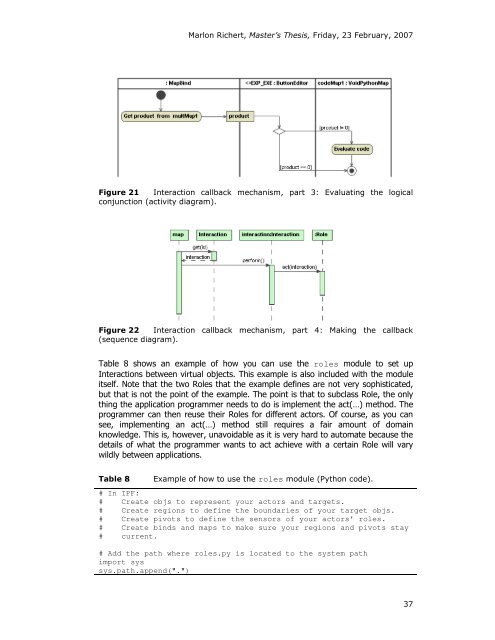The AR Workbench: A Complete Co-located Reach-in Mirror-Based ...
The AR Workbench: A Complete Co-located Reach-in Mirror-Based ...
The AR Workbench: A Complete Co-located Reach-in Mirror-Based ...
You also want an ePaper? Increase the reach of your titles
YUMPU automatically turns print PDFs into web optimized ePapers that Google loves.
Marlon Richert, Master’s <strong>The</strong>sis, Friday, 23 February, 2007<br />
Figure 21 Interaction callback mechanism, part 3: Evaluat<strong>in</strong>g the logical<br />
conjunction (activity diagram).<br />
Figure 22 Interaction callback mechanism, part 4: Mak<strong>in</strong>g the callback<br />
(sequence diagram).<br />
Table 8 shows an example of how you can use the roles module to set up<br />
Interactions between virtual objects. This example is also <strong>in</strong>cluded with the module<br />
itself. Note that the two Roles that the example def<strong>in</strong>es are not very sophisticated,<br />
but that is not the po<strong>in</strong>t of the example. <strong>The</strong> po<strong>in</strong>t is that to subclass Role, the only<br />
th<strong>in</strong>g the application programmer needs to do is implement the act(…) method. <strong>The</strong><br />
programmer can then reuse their Roles for different actors. Of course, as you can<br />
see, implement<strong>in</strong>g an act(…) method still requires a fair amount of doma<strong>in</strong><br />
knowledge. This is, however, unavoidable as it is very hard to automate because the<br />
details of what the programmer wants to act achieve with a certa<strong>in</strong> Role will vary<br />
wildly between applications.<br />
Table 8 Example of how to use the roles module (Python code).<br />
# In IPF:<br />
# Create objs to represent your actors and targets.<br />
# Create regions to def<strong>in</strong>e the boundaries of your target objs.<br />
# Create pivots to def<strong>in</strong>e the sensors of your actors' roles.<br />
# Create b<strong>in</strong>ds and maps to make sure your regions and pivots stay<br />
# current.<br />
# Add the path where roles.py is <strong>located</strong> to the system path<br />
import sys<br />
sys.path.append(".")<br />
37
















